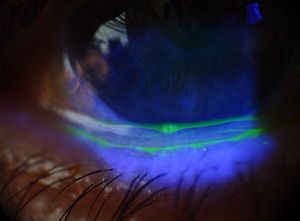Conjunctivochalasis
| Conjunctivochalasis | |
|---|---|
 |
|
| An eye with conjunctivochalasis. | |
| Classification and external resources | |
| Specialty | ophthalmology |
| ICD-10 | |
| ICD-9-CM | 372.81 |
Conjunctivochalasis is a common eye surface condition characterized by the presence of excess folds of the conjunctiva located between the globe of the eye and the eyelid margin.
Symptoms range from , epiphora, and irritation, to localized pain, foreign body sensation, subconjunctival hemorrhage, and ulceration. Symptoms are often made worse by vigorous blinking. Diagnosis can be made under a slit lamp upon the observation of redundant conjunctival folds. These folds can be made more apparent by staining with fluorescin dye and by applying gentle upward pressure with a finger to the eyeball through the lower lid. A tear-clearance test can also detect irregularities in the tear-film.
Most conjunctivochalasis is thought to be caused by both a gradual thinning and stretching of the conjunctiva that accompanies age and a loss of adhesion between the conjunctiva and underlying sclera due to the dissolution of Tenon's capsule. The resulting loose, excess conjunctiva may mechanically irritate the eye and disrupt the tear film and its outflow, leading to dry eye and excess tearing. A correlation may also exist between inflammation in the eye and conjunctivochalasis; though it is unclear if this correlation is causal. Conjunctivochalasis may be associated with previous surgery, Blepharitis, Meibomian Gland Disorder (MGD), Ehlers-Danlos Syndrome, and Aqueous Tear Deficiency,
Because the disorder often occurs in people with typical dry eye symptoms, it can be difficult to distinguish readily the discomfort caused by the dry eye from that directly related to the redundant conjunctiva.
Mild conjunctivochalasis can be asymptomatic and in such cases does not require treatment. Lubricating eye drops can be tried but do not often work.
If discomfort persists after standard dry eye treatment and anti-inflammatory therapy, surgery can be undertaken to remove the conjunctival folds and restore a smooth tear film. This conjunctivoplasty surgery to correct conjunctivochalasis typically involves resection of an ellipse-shaped segment of conjunctiva just inferior to the lower lid margin, and is usually followed either by suturing or amniotic membrane graft transplantation to close the wound.
...
Wikipedia
